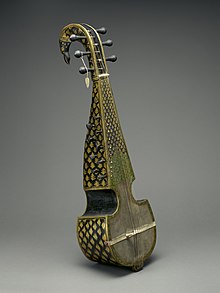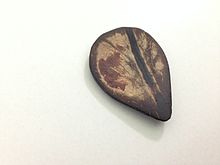
The sitar is a plucked stringed instrument, originating from the Indian subcontinent, used in Hindustani classical music. The instrument was invented in the 18th century, and arrived at its present form in 19th-century India. Khusrau Khan, an 18th-century figure of the Mughal Empire has been identified by modern scholarship as the inventor of the sitar. According to most historians, he developed the sitar from the setar, an Iranian instrument of Abbasid or Safavid origin.
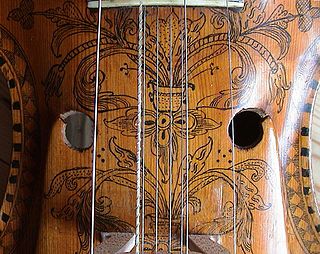
Sympathetic strings or resonance strings are auxiliary strings found on many Indian musical instruments, as well as some Western Baroque instruments and a variety of folk instruments. They are typically not played directly by the performer, only indirectly through the tones that are played on the main strings, based on the principle of sympathetic resonance. The resonance is most often heard when the fundamental frequency of the string is in unison or an octave lower or higher than the catalyst note, although it can occur for other intervals, such as a fifth, with less effect.

Surbahar sometimes known as bass sitar, is a plucked string instrument used in the Hindustani classical music of the Indian subcontinent. It is closely related to the sitar, but has a lower pitch. Depending on the instrument's size, it is usually pitched two to five whole steps below the standard sitar.
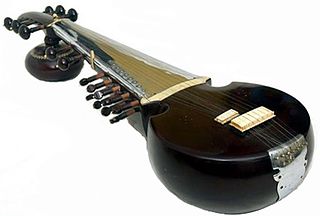
Mohan veena refers to either of two distinct plucked string instruments used in Indian classical music, especially Hindustani classical music which is associated with the northern parts of the Indian subcontinent.

Ustad Amjad Ali Khan is an Indian classical sarod player, best known for his clear and fast ekhara taans. Khan was born into a classical musical family and has performed internationally since the 1960s. He was awarded India's second highest civilian honor Padma Vibhushan in 2001, India's third highest civilian honor Padma Bhushan in 1991 and Padma Shree in 1975.
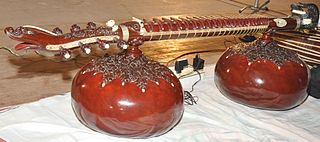
The Rudra veena —also called Bīn in North India—is a large plucked string instrument used in Hindustani Music, especially dhrupad. It is one of the major types of veena played in Indian classical music, notable for its deep bass resonance.

Rubab, Robab, or Rabab is a lute-like musical instrument.The rubab is the national musical instruments of Afghanistan, is also commonly played in Pakistan and India mostly by Pashtuns and Balochis, Sindhis, Kashmiris and Punjabis. Variants of the rubab include the Kabuli rebab of Afghanistan, the Rawap of Xinjiang, the Pamiri rubab of Tajikistan and the seni rebab of northern India. The instrument and its variants spread throughout West, Central, South and Southeast Asia. The Kabuli rebab from Afghanistan derives its name from the Arabic rebab and is played with a bow while in Central Asia and the Indian subcontinent, the instrument is plucked and is distinctly different in construction.

Buddhadev Das Gupta was an Indian classical musician who played the sarod. He used to reside in Kolkata, India. He was one of the artists featured in Nimbus Records' The Raga Guide.
The Maihar Gharana or Maihar-Senia Gharana is a gharana or school of classical music, a style of Indian classical music originating in the northern parts of the Indian subcontinent. The school was formed by Allaudin Khan in the princely state of Maihar, now in the central Indian state of Madhya Pradesh, and hence the name. Allauddin Khan learnt music from Vina player Wazir Khan, an exponent of the Senia gharana. The Maihar gharana is therefore sometimes referred to as the Maihar-Senia gharana.

Radhika Mohan Maitra (1917–1981) was an Indian sarod player and the guru of Narendra Nath Dhar, Kalyan Mukherjea, Buddhadev Das Gupta, Sanjoy Bandopadhyay, Abanindra Maitra, Pranab Kumar Naha, Samarendra Nath Sikdar, Michael Robbins, and many other musicians of this generation. Maitra was considered an influential figure in 20th century sarod playing and received the title Sangeetacharya. He was among those awarded the Sangeet Natak Akademi Award in 1971.
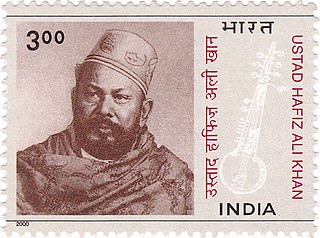
Hafiz Ali Khan was an Indian sarod player.

The sursingar, sursringar or surshringar, is a musical instrument originating from the Indian subcontinent having many similarities with the sarod. It is larger than the sarod and produces a deeper sound. It precedes the sarod chronologically.

Asad Ali Khan was an Indian musician who played the plucked string instrument rudra veena. Khan performed in the style dhrupad and was described as the best living rudra veena player in India by The Hindu. He was awarded the Indian civilian honor Padma Bhushan in 2008.
Ayaan Ali Bangash is an Indian classical musician who plays the sarod. Khan is the son of Amjad Ali Khan and often performs with his older brother Amaan Ali Bangash, with whom he hosted the music talent show Sa Re Ga Ma. He has also released solo albums and collaborations with brother and father.

Sharan Rani was an Indian classical sarod player and music scholar.
Ustad Sakhawat Hussain Khan or Sakhawat Hussain (1877–1955) was a virtuoso Indian sarod player, a contemporary of Hafiz Ali Khan and one of the major exponents of the instrument in the 20th century.

The veena, also spelled vina, is any of various chordophone instruments from the Indian subcontinent. Ancient musical instruments evolved into many variations, such as lutes, zithers and arched harps. The many regional designs have different names such as the Rudra veena, the Saraswati veena, the Vichitra veena and others.

Narendra Nath Dhar is an Indian classical musician who plays the sarod, a string instrument. One of the finest exponents of the Shahjahapur/Gwalior Seniya Gharana, he is known for his purist style of play as well as his own emerging style. His style of playing can be distinguished from that of others.
Wahid Khan, more commonly known as Wahid Khan Beenkar or Indorewale Wahid Khan, was an Indian classical rudra veena player and, along with his younger brother Ghagge Nazir Khan, founded the Mewati gharana, later popularized by Pandit Jasraj and Rais Khan.
Bhaiyya Ganpatrao, alias "Sughar-piya", (1852–1920) was a member of the Gwalior royal family and known for pioneering the harmonium as an accompanying instrument. He was a member of the Gwalior gharana school of classical music.
